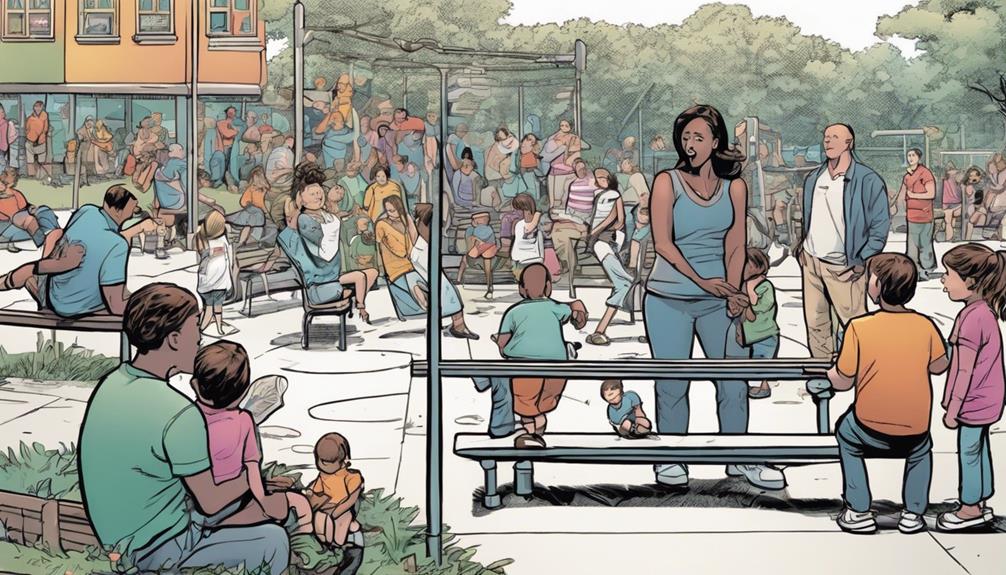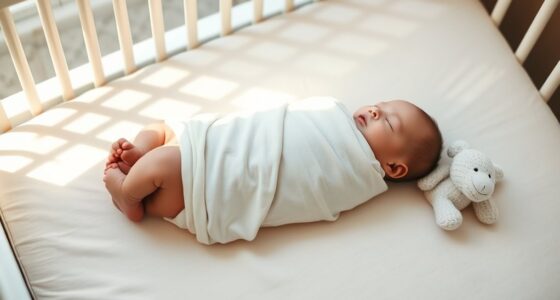To babyproof your home effectively, start by clearing clutter and securing outlets in the living room. Use safety latches on kitchen cabinets and keep sharp or small items out of reach in bedrooms and bathrooms. Install safety gates and window locks on stairs and in outdoor areas. Regularly check and maintain safety devices, and remove hazards from all rooms. If you want detailed steps for each space, continue exploring to create a safe environment for your child.
Key Takeaways
- Secure furniture, cords, and electrical outlets in every room to prevent falls and electrical hazards.
- Install safety devices like cabinet locks, door handles, and stair gates to restrict access to dangerous areas.
- Keep small objects, sharp items, and cleaning supplies out of reach in kitchens, bathrooms, and nurseries.
- Use anti-slip mats, window locks, and proper lighting to reduce fall risks throughout the home.
- Regularly inspect and maintain safety features, ensuring a clutter-free environment for your child’s safety.
Living Room Safety Measures
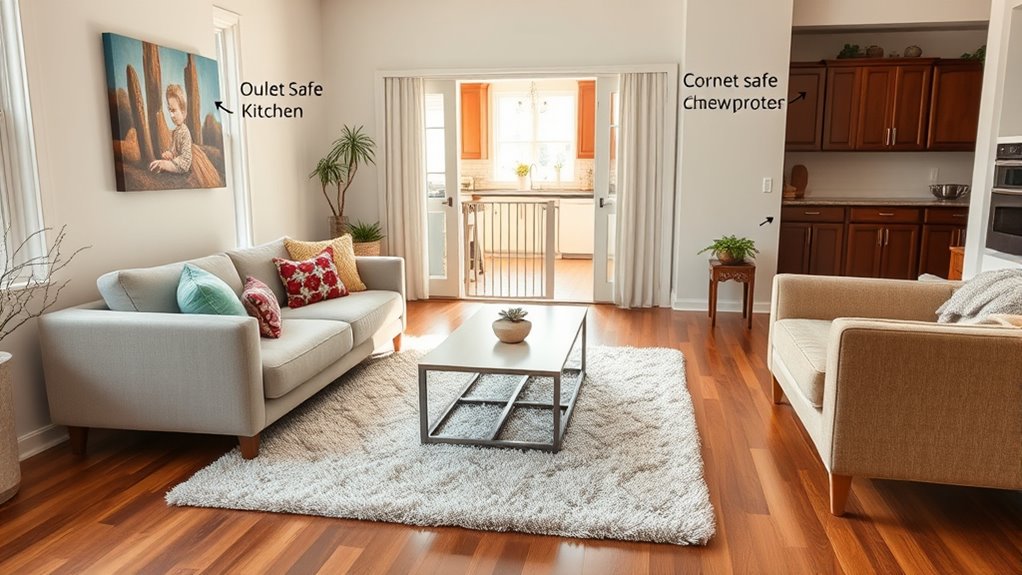
Creating a safe living room environment is essential because this is often the area where your baby spends a lot of time playing and exploring. To prevent fire hazards, keep the space clear of clutter that could catch fire, like newspapers or paper waste. Regularly check for exposed electrical outlets, and use outlet covers to prevent your baby from sticking fingers or objects into them. Avoid overloaded power strips, which can overheat and cause fires. Make sure all cords or wires are out of reach or secured, so your baby can’t pull or chew on them. Keep heaters, candles, and other heat sources away from furniture or curtains. Additionally, using safety-approved outlet covers can further reduce the risk of electrical accidents. Incorporating child-safe lighting can help minimize electrical hazards and create a well-lit environment for your little one. Proper Electrical wiring maintenance in your living room can also prevent electrical hazards related to moisture and wiring. Ensuring that your home’s power capacity is adequate prevents overloads that could lead to fire hazards. By addressing fire hazards and securing electrical outlets, you create a safer environment for your little explorer.
Kitchen Precautions and Tips

You can keep your little one safe in the kitchen by using secure storage for sharp knives, cleaning supplies, and small objects. Childproof appliance handles prevent curious hands from pulling down hot or heavy appliances. Taking these simple steps helps create a safer environment for your child while you cook. Additionally, installing safety latches on cabinets and drawers can prevent access to potential hazards that may not be immediately obvious. Being aware of home safety principles can also help in recognizing early signs of overlooked dangers or concerns related to home safety. Incorporating current safety guidelines ensures you are following the latest best practices for household childproofing. Staying informed about safety innovations can further enhance your home’s security measures.
Safe Storage Solutions
To prevent accidents in the kitchen, it is crucial to store hazardous items out of your child’s reach. Proper storage minimizes risks from medication storage and cleaning supplies. Here are essential tips:
- Keep all medication storage in high cabinets or locked drawers to prevent accidental ingestion.
- Store cleaning supplies in a secure, childproof cabinet, away from food and utensils.
- Use safety latches on cabinets and drawers containing hazardous items to add an extra layer of protection.
- Selecting appropriate storage solutions, such as childproof locks, can significantly enhance safety and prevent access to dangerous substances.
- Be aware of necessary cookies that enable basic site functionalities, ensuring your safety and privacy during online research on childproofing measures.
- Incorporating childproof storage solutions into your home setup can further reduce risks by keeping potentially harmful items securely out of reach.
Childproof Appliance Handles
Since appliance handles are often within a child’s reach, it’s essential to childproof them to prevent accidental injuries. You can improve appliance safety by installing handle covers on stovetops, ovens, and microwaves. Handle covers create a barrier that makes handles less accessible and uncomfortable for little hands, discouraging children from pulling or pulling on appliances. Regularly check that the covers are securely in place and in good condition. Keep in mind that unplugging appliances when not in use adds an extra layer of safety. Additionally, understanding sensor technology and their effects can help in creating a calming environment that may reduce a child’s tendency to explore dangerous areas. Being aware of building codes and safety standards ensures your modifications meet safety requirements and provide optimal protection. Incorporating interior safety measures like secure cabinet latches and outlet covers further enhances overall kitchen safety. Implementing professional architectural solutions can also ensure that your childproofing measures are both effective and compliant with safety standards. By taking these simple steps, you reduce the risk of burns, scalds, or other accidents. Childproofing appliance handles is a quick, effective way to create a safer kitchen environment for your little one.
Bedroom Security Strategies
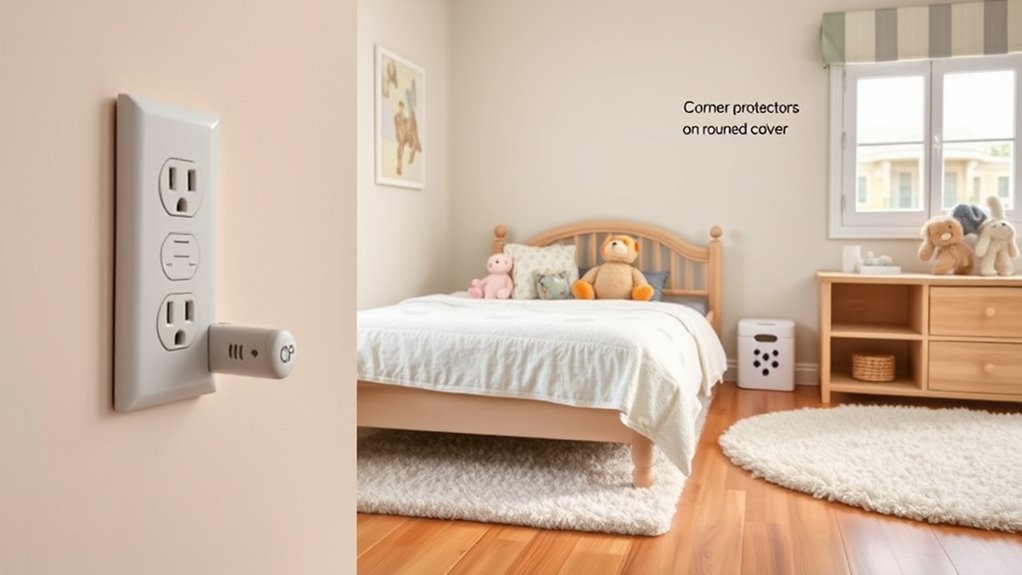
Creating a safe sleep environment is essential, so guarantee your child’s bed is free of loose bedding and pillows. Check that clothing and toys in the room are age-appropriate and free of small parts that could pose a choking hazard. By securing these elements, you help minimize risks and promote a safer bedroom for your little one. Incorporating data privacy considerations into your safety checks can further protect your child’s information and digital footprint. Additionally, understanding city dynamics can assist in choosing safe neighborhoods with appropriate amenities for families. Incorporating water safety measures, such as window locks and outlet covers, can also reduce potential hazards in the child’s environment. Implementing home safety technology can also enhance security and monitor potential hazards in the child’s environment.
Secure Sleep Environment
Ensuring a secure sleep environment is essential for your baby’s safety and peace of mind. Proper crib safety helps prevent accidents and promotes restful sleep. To optimize your baby’s sleep environment, consider these key strategies:
- Check crib safety: Ensure the mattress fits snugly without gaps, avoid drop-side cribs, and remove loose bedding or toys.
- Create a safe sleep space: Keep the sleep environment free of pillows, stuffed animals, and heavy blankets that could pose suffocation risks.
- Maintain a comfortable temperature: Keep the room at a steady, cool temperature to prevent overheating, which is linked to SIDS.
Following these steps helps create a safe, comfortable sleep environment for your little one.
Clothing & Toy Safety
A safe sleep environment extends beyond the crib itself to include the clothing and toys in your baby’s room. Always check clothing labels to ascertain outfits are free of loose buttons, cords, or embellishments that could pose choking hazards. Opt for simple, well-fitting clothing without strings or ties that could wrap around your baby’s neck. When it comes to toys, inspect for small parts that can detach easily, creating toy choking hazards. Regularly remove broken or damaged toys and keep all items age-appropriate. Store toys and clothing out of reach, especially for younger babies who might put everything in their mouth. By paying attention to clothing labels and eliminating toy choking hazards, you create a safer, more secure environment for your little one to sleep and explore.
Bathroom Babyproofing Essentials
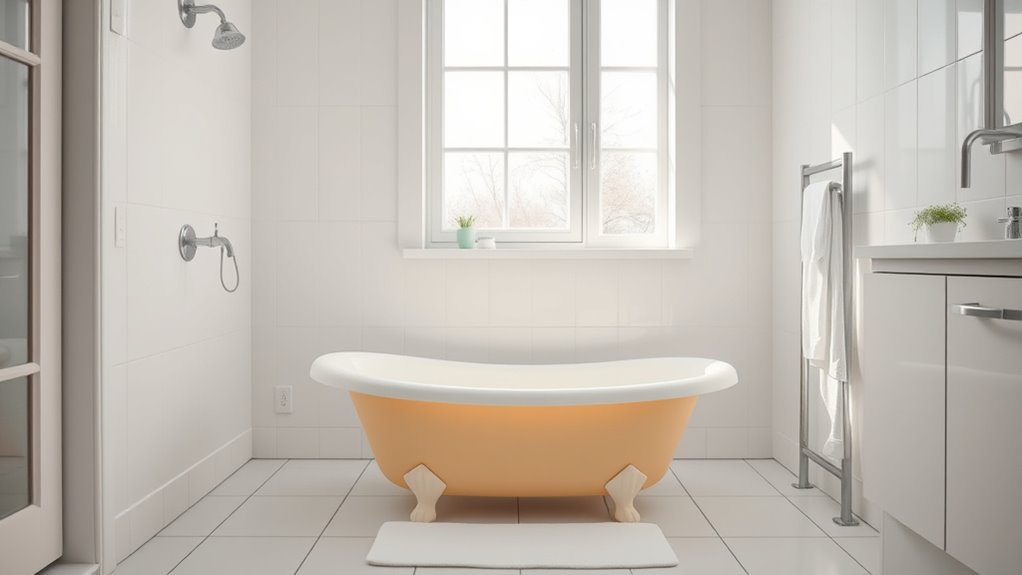
Bathroom safety is crucial because it’s one of the most accident-prone areas in your home. To keep your little one safe, focus on key areas like bathtub safety and toilet safety.
Here are three essential tips:
- Install anti-slip mats in the bathtub and on the bathroom floor to prevent slips.
- Use covers on the toilet to prevent accidental falls or pinched fingers.
- Never leave your child unattended in the bathroom, especially during bath time, and keep all sharp or hazardous items out of reach.
Nursery Safety Checks
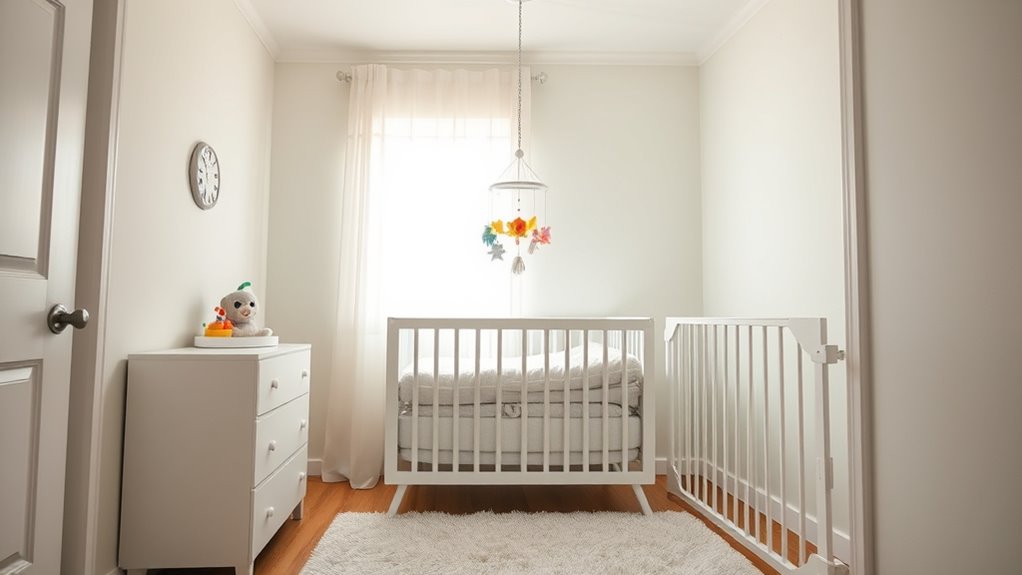
Regularly inspecting the nursery is key to maintaining a safe environment for your baby. Check nursery furniture for stability—tighten loose screws and ensure nothing wobbles or tips over easily. Focus on crib safety by examining slats to confirm they’re spaced no more than 2-3/8 inches apart, preventing your baby from slipping through. Look for any broken or splintered wood, sharp edges, or peeling paint that could harm your little one. Remove any clutter or small objects within reach that pose choking hazards. Ensure all cords from nightlights or electronic devices are out of your baby’s reach, and verify that crib mattresses fit snugly without gaps. Regular nursery safety checks help you catch potential dangers early and keep your baby’s space secure.
Hallways and Staircases Safeguarding

Since hallways and staircases are common pathways in your home, safeguarding them is essential to prevent accidents. Start by installing a sturdy stair gate at the top and bottom of stairs to prevent falls. Ensure the gate is properly placed, with no gaps or loose fittings. Next, check that handrails are securely installed along staircases, providing support for your child and reducing slipping risks. Keep the area clear of clutter and cords that could cause tripping. You might also consider adding non-slip treads to stairs for extra traction. Regularly inspect gates and handrails for stability and wear. These simple steps create a safer environment, giving you peace of mind as your little one explores their home.
Outdoor Area Safety Considerations
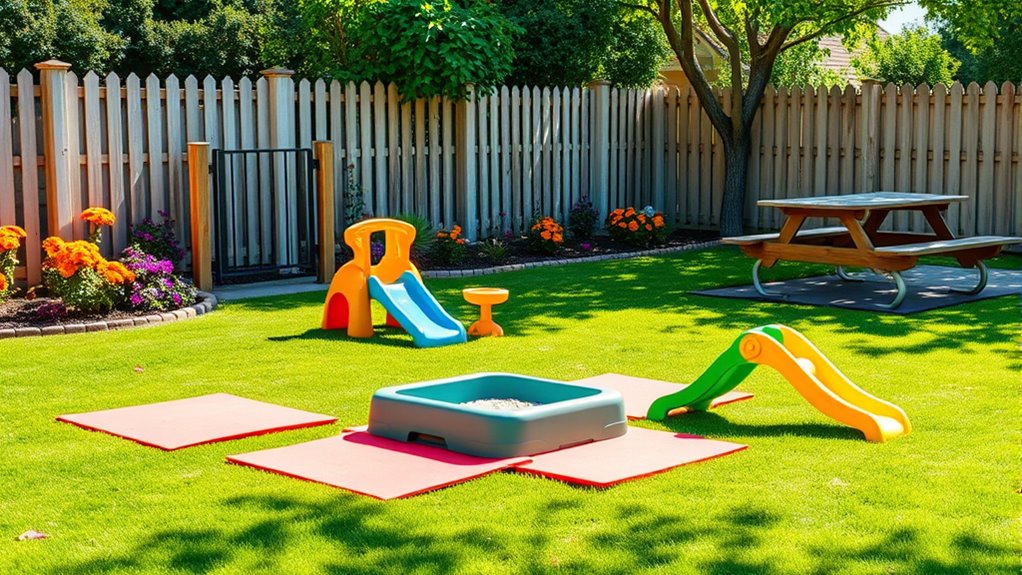
Creating a safe outdoor space for your little one involves more than just supervision; it requires careful planning and proactive measures. Regularly inspect and maintain your fence to ensure there are no loose boards, gaps, or sharp edges that could pose a risk. A secure fence keeps your child safely contained and prevents them from wandering off. Designate specific outdoor play zones, using soft surfaces like mulch or rubber mats to cushion falls. Keep these areas free of hazards such as sharp tools, gardening chemicals, or debris. Ensure gates are self-closing and locked when not in use. By maintaining your fence and creating dedicated, hazard-free outdoor play zones, you help your child enjoy outdoor activities safely and confidently.
General Home Safety Tips
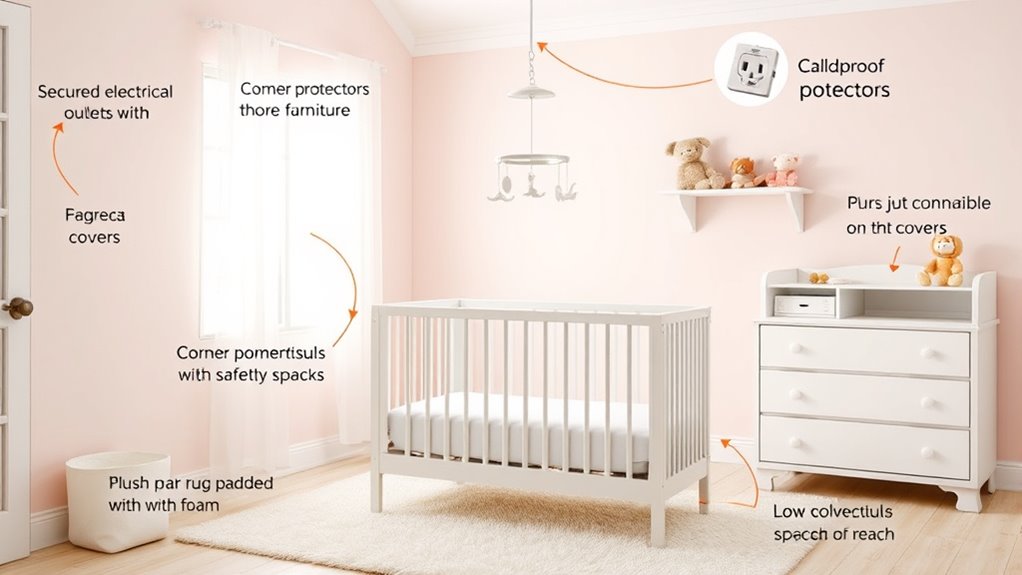
To keep your home safe for your little one, it’s essential to identify and address common hazards throughout your living space. Start by focusing on fire prevention—install smoke alarms, keep fire extinguishers accessible, and avoid leaving open flames unattended. Next, ensure electrical safety by covering outlets, avoiding overloaded power strips, and securing cords out of reach. Finally, keep pathways clear of clutter to prevent trips and falls. Regularly check for hazards like loose rugs or furniture that could tip over. By taking these simple steps, you reduce risks and create a safer environment for your child. Remember, proactive safety measures safeguard your little one from preventable accidents and foster peace of mind in your home.
Frequently Asked Questions
How Often Should I Reassess My Home’S Safety Measures?
You should reassess your home safety regularly to guarantee babyproofing stays effective. Experts recommend reviewing your home safety and adjusting your babyproofing schedule at least every three to six months, especially as your child grows and becomes more mobile. Keep an eye out for new hazards, changes in furniture, or household items that may need securing. Staying vigilant helps prevent accidents and keeps your home a safe environment for your little one.
What Are the Best Childproof Locks for Cabinets?
Ironically, finding the best childproof lock is easier than keeping your little explorer out of cabinets! For simplicity and security, a sturdy cabinet latch or a reliable childproof lock works wonders. Look for options that are easy for adults to open but tricky for tiny hands. Brands like Safety 1st or Munchkin offer top-rated cabinet latches. Trust me, your peace of mind will thank you as your kid learns to open and close cabinets safely.
How Can I Prevent Burns in the Kitchen?
To prevent burns in the kitchen, you should focus on reducing fire hazards and ensuring appliance safety. Keep pot handles turned inward, so little hands can’t grab them, and stay in the room when cooking. Use stove guards and oven locks to block access, and keep hot liquids away from edges. Regularly check cords and appliances for damage, and never leave cooking unattended to maintain a safe environment for your child.
Are There Specific Safety Standards for Furniture?
You should look for furniture that meets safety standards, ensuring it’s stable and sturdy. Check for furniture stability by securing heavy pieces to the wall to prevent tipping. Safety standards often require rounded corners, non-toxic finishes, and proper anchoring. Always follow manufacturer instructions for installation and use. By choosing furniture that adheres to safety standards and securing it properly, you reduce the risk of accidents and keep your home safer for everyone.
How Can I Make Outdoor Play Areas Safer for Babies?
Did you know that falls are a leading cause of injury in outdoor play areas? To make these spaces safer, always supervise your baby during outdoor play, ensuring constant outdoor supervision. Check that play equipment is sturdy and age-appropriate, and remove any sharp objects or hazards from the area. Adding soft ground cover like mulch or rubber mats can cushion falls, giving you peace of mind while your baby explores safely.
Conclusion
Just like building a sturdy fortress, babyproofing your home creates a safe haven for your little one. I once watched a mom double-checking her stair gates after her toddler took a tumble — a gentle reminder that safety isn’t a one-time task, but an ongoing effort. By rooming your home with care, you’re not just preventing accidents; you’re crafting a peaceful space where your child can explore confidently, knowing they’re protected at every turn.



